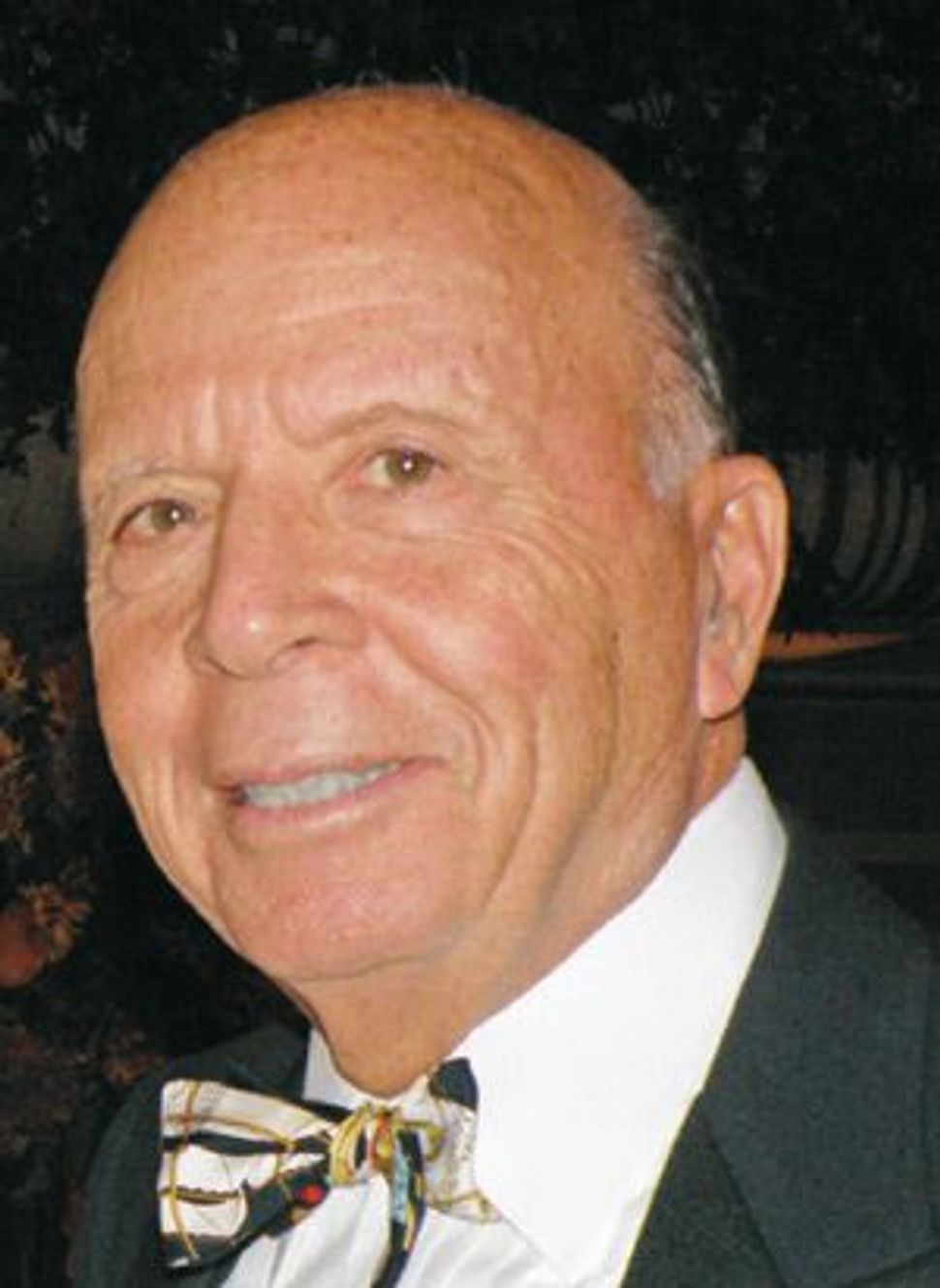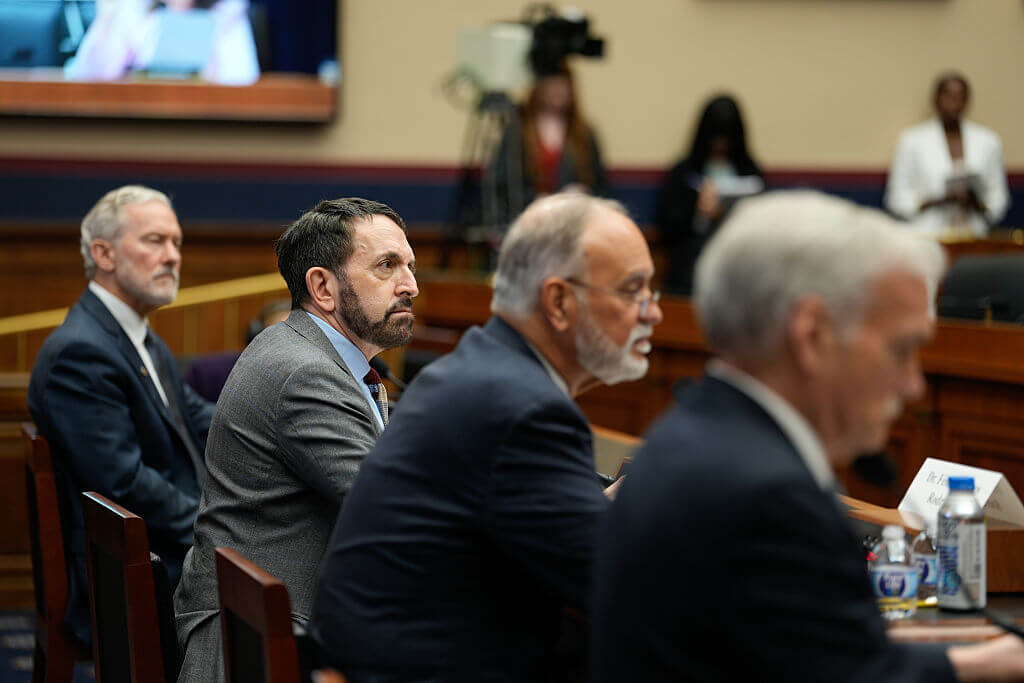A Medical Merger

Man of Many Hats: Saul Katz Image by KAREN LEON
A Medical Mazel Tov for the Merger of Manhattan’s Lenox Hill Hospital With North Shore Long Island Jewish Health Systems
“Three years ago we gathered here to celebrate 150 years,” William Hiltz, Lenox Hill Hospital’s executive committee chairman, told the 900 black-tie guests at its November 1 Autumn Ball. Beaming, he said that “the evening raised $3 million,” and he touted Lenox’s merger with North Shore Long Island Jewish Health Systems. Richard Goldstein, chairman of the board of trustees of NSLIJ, stated that with Lenox Hill Hospital as its Manhattan flagship, NSLIJ is now “the largest integrated health care provider in New York State and the second largest in the U.S.”
It was “Play ball!” at the Waldorf-Astoria for the merger, where baseball rivalries were put aside. For among the evening’s co-chairs were Daniel Crown (minority owner of the New York Yankees) and benefit committee member Saul Katz (president of the New York Mets and the Brooklyn Cyclones). When asked where his family was from, Katz replied, “The family came from Zlotchev, outside Lvov [in Poland].” He added, “Of the community… none survived.” At another event, Katz had amplified: “When my mother was asked whether she came from Poland or Russia, she’d say, ’Depends on whether the Cossacks were coming or going.’” Ergo the town is spelled Zloczow (Polish), Zolochev (Russian) or Zolochiev (Ukrainian).
Michael Dowling, president and CEO of NSLIJ, amplified: “We will become one, yet will maintain [our] distinctive characteristics. Together we will serve all — irrespective of circumstances. For the first time in 35 years, New York State has a new medical school that NSLIJHS and Hofstra University will open for students in the summer of 2011.”
Lenox Hill Hospital, a 652-bed, fully accredited acute-care hospital on Manhattan’s Upper East Side, was unique from its beginnings. It was founded in 1857 as the German Dispensary by Abraham Jacobi (1830–1919), who is often referred to as “the father of American Pediatrics,” and by Ernst Krackowizer (1821–1875). In their profiles (in the Jewish Encyclopedia), Jacobi is credited with the invention of the laryngascope and as one of the first Americans to use the diphtheria anti-toxin in his practice. Krackowizer is noted for being the first in Vienna to experiment on himself to get the effect of chloroform.
Ruth Messinger — Center Stage at American Jewish World Service Gala
“I want us to travel to the rest of the world… with its teeming slums…. I want us to be with [the] 1 billion who go to bed hungry….” Ruth Messinger, president of American Jewish World Service, told the crowd at the October 28 event “An Evening With American Jewish Service,” held at the Frederick P. Rose Hall at Jazz at Lincoln Center. Nine ceremonial drummers augmented by cast members from the Broadway cast of “Fela!” set the evening’s tempo. ABC news anchor Christiane Amanpour offered a salute to Larry Phillips, who with Larry Simon founded the AJWS in 1985. As was noted from the stage and in the printed program: “It was his vision of harnessing American Jewish philanthropy to address the ills of global poverty… to create the first American Jewish organization dedicated to alleviating poverty, hunger and disease among the people of the world, regardless of religion.”
“For the past eight years I have covered some of the world’s largest crises,” Amanpour said. “In the heart of every hotspot I have reported from, I have encountered one constant: an unflagging fight for justice led by the women and men supported by AJWS.” To date, AJWS has funded more than 1,000 grassroots projects in 70 countries. It has sent 3,400 volunteers into the field. And last year, AJWS reached $100,000,000 in grants. Amanpour noted that within 48 hours of this year’s January 12 earthquake that struck Haiti, “AJWS responded, with the help of 17 local Haitian grantees who distributed food, water, purification systems… and medicine.”
The evening’s program included a message from President Obama, which closed with: “Across the nation and around the world, organizations like AJWS have lifted up countless lives through disaster relief, economic development and health initiatives…. I wish you the best.”
Remembering Composer Jerry Bock, Whose Melodies Came From the Heart and Touched the World
In November 1990, in the pouring rain, I had my first meeting with composer Jerry Bock under the marquee of the Circle in the Square Theatre, where a critically acclaimed revival of “The Rothschilds” was playing to a standing-room audience. Unfurling a huge umbrella, he led me inside a nearby coffee shop. Bock (who died November 3, at 81) wrote the music for “Fiddler on the Roof,” “Fiorello!” and “She Loves Me” He cautioned me, ”What I really want to talk about is ‘The Rothschilds.’” During that musical’s 1970 original production, Bock’s partnership with lyricist Sheldon Harnick had unraveled and at the time of our chat the two had still not reconciled. “I also remember the negative reviews the original [production] received,” I told Bock, who was leaning back in the chair, smiling.
Bock replied: “The critics literally took back their words from the original reviews. It’s amazing that this is the same show they did not like the first time around! Sheldon and I waned to stay a team. Of course, the thing that entrapped us 20 years ago was that ‘The Rothschilds’ was only one show away from ‘Fiddler’ and was running at the same time. People thought we were trying to cash in on a success. So the comparison became deadly. Actually I don’t know how you write a success in the first place, much less duplicate one.”
What was the genesis of “Fiddler?” I asked. Bock paused, then replied: “Someone asked us to read Sholom Aleichem. I was intrigued by the characters, so I showed it to Sheldon and he agreed…. We talked to Joe [Stein], who wrote the book. [This past October, 98-year-old Joseph Stein died.] But Joe knew Sholom Aleichem intimately — and in Yiddish — so we all read the collection and it absolutely wiped us out…. [“Fiddler”] allowed me to express everything that was inside me from my grandmother. [Sholom Aleichem] was the vessel from which I could write music. He allowed me to express myself musically in a way that I had never done before!”
Bock’s maternal grandparents came from Vilna. As for his father’s parents, he told me, “One was Hungarian, the other German,” but he didn’t specify who came from where.
Whatever the fallout between lyricist Harnick and composer Bock, judging from the April 17, 2002, “Sheldon Harnick in Concert: An Evening With a Musical Legend,” held under the auspices of the YIVO Institute for Jewish Research and the Sholom Aleichem Memorial Foundation, a reconciliation seemed to have taken place. Harnick — at the piano — performed several outtakes from “The Rothschilds” and “Fiddler.” He recounted that when “working on ‘Fiddler,’ Jerry and I decided to use Yiddish words that all would understand. One result is the now familiar ‘L’Chaim’ —To life!” Harnick recalled that at one performance, after the cast exclaimed ‘Mazel Tov!’ Jacqueline Kennedy, who was in the audience, asked her companion, ‘What does that mean?’” Harnick laughed: “Five rows of people around her whispered, ‘Congratulations!’”
During the 2004 Broadway revival of “Fiddler,” starring Alfred Molina as Tevye, the American Jewish Historical Society sponsored the August 15 Dialogue Forum Series, run by Rabbi William Berkowitz at the Center for Jewish History and showcasing Molina, Harnick and Bock. There was nary a hint of the past breakup between the latter two. Bock told the audience: “When Joe Stein was in Tokyo for an opening of ‘Fiddler,’ the producer asked him. ‘How can an American audience appreciate a show that is so essentially Japanese?’” Molina concurred: A friend of his from Calcutta who came to see the show “was in tears! ‘This is so Indian! Tevye agonizes about what Indian parents agonize about — marrying out!’” At the January 21, 2005, opening night production of the “Fiddler” revival at the Minskoff Theatre, starring Harvey Fierstein (who has neither a wife nor daughters to break his heart) as Tevye, sitting in the row behind me, “Fiddler’s” the three creators — Bock, Harnick and Stein — were kvelling as if it were the original opening night performance of “Fiddler.”
Generation-to-Generation Dinner: Celebrating Continuity at the Museum of Jewish Heritage—A Living Memorial to the Holocaust
“Vos makht a mayor?” — “How goes it, mayor?” is how I greeted former New York City mayor Ed Koch as he was nibbling on fennel salad at the November 3 “Generation to Generation” 22nd Annual Dinner of the Museum of Jewish Heritage—A Living Memorial to the Holocaust. “That’s good. I like that,” he replied as he turned to his table companion, museum chairman Robert Morgenthau. “This is our family dinner,” museum director David Marwell said. “We talk of loved ones [who are] sorely missed,” a fact verified by the smaller-than-past-years number of Holocaust survivors who were asked to stand up so that they could be acknowledged. Marwell continued: “This is a tribute… to tell the story of survivors… a thank you to survivors — to the second, third and even fourth generation…. Because we lose so many survivors, [we] expand for each grandchild. This [museum] is a testament to the world built by you and you and you.”
“We can’t forget the parents, grandparents, children who did not survive,” museum vice chair Ann Oster said. “‘This is what you can’t forget,’ my mother said to me, ‘when you make the bar and bat mitzvahs for your [own] children.” A video of concentration camp survivors Moritz and **Angie Goldfeier, who lived to schep nakhas and experience joy and pleasure at bar mitzvahs of their sons and grandsons, was warmly documented in home movies of the generationally expanding Goldfeier family.
Addressing the nearly 400 guests in the museum’s third-floor dining room, with its spectacular view of the harbor and the Statue of Liberty, Marwell informed: “What you could not see this evening were the more than 50,000 school children and their teachers and the thousands of others who visited us last year. Touting the museum’s recent exhibition “Project Mah Jongg,” and the just-opened “Fire in My Heart: The Story of Hannah Senesh,” he gave advance notice of upcoming exhibits: “Last Folio,” about the remains of Jewish life in Slovakia (March 2011), and “Emma Lazarus: Mother of Exiles” (October 2011).





















